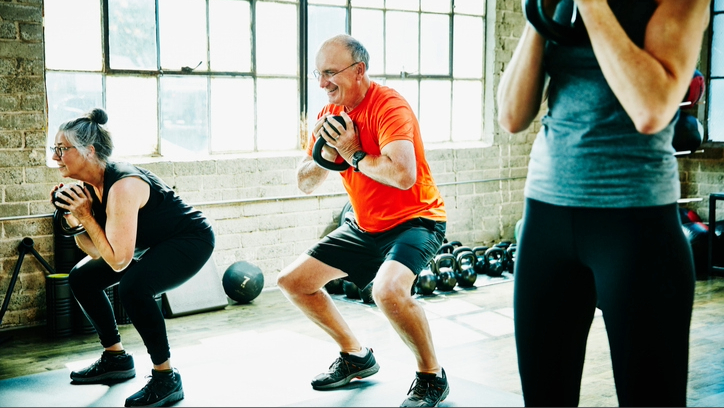5 exercises that reverse aging — according to a physiotherapist
Prevent and reverse muscle loss with these 5 moves.

Forget cardio for a moment. If you want to reverse the effects of aging on the body, you're going to want to focus on strength training. A physiotherapist recommends trying these five exercises, which are backed by science. You can use your bodyweight to perform them, or add a set of the best adjustable dumbbells or weights of your choice to increase resistance and intensity.
Shrey Vazir, founder of Mind Body Horizons, is a physiotherapist with over 300K subscribers who are looking to improve their pain, performance and mobility through strength training and rehab.
But you’ll be surprised, because we’re not talking about lifting heavy weights here — just adding simple compound exercises to your routine gradually, using your bodyweight.
These are especially useful to help fight against sarcopenia — muscle mass loss that accelerates as you reach over 50 years old. According to research (more on that below), it’s both preventable and reversible in just 12 weeks with the right exercises.
Here they are.
What are the 5 anti-aging exercises?
These exercises focus on the key muscle groups in the body and can be scaled accordingly to suit your ability. And the best bit is, we're hardly breaking the internet here; these are all well-known exercises that most people can manage with a little guidance.
1. Squats
Squats target the hips, quads, hamstrings and glutes, but also your back and core, improving trunk stability and endurance. Vazir tells us that squat strength can translate to performing everyday activities better, picking up an object off the floor or getting up from the sofa, for example.
Get instant access to breaking news, the hottest reviews, great deals and helpful tips.
Try two sets of 10 reps and hold a weight to make squats harder. You can also use a chair to make it easier, sitting on the seat with every rep. Increase the reps and sets as you get stronger.
Vazir also recommends following the “Golden Rule of Rehab,” which is consistency and progress over intensity — this is progressive overload.
Here’s how to do squats step-by-step.
2. Modified crunches
Your back and core benefit from the modified crunch. This move hits the abs, but also the deeper core muscles, including the transverse abdominis and multifidus. Vazir explains how to do this step-by-step, but we also cover how to do crunches, with variations to try.
Vazir’s variation is accessible for most people and supports the lower back, so it’s worth trying if you prefer an entry-level crunch exercise. Whichever version you try, never pull with your neck — drive with your core muscles and continue to breathe.
Vazir recommends adding more reps, holding a weight to your chest or reaching your upper back higher off the mat to progress the crunch, or performing a partial crunch with less range of motion if you need to scale things back.
Start with two sets of 15 reps.
3. Reverse lunges
“Lunges engage your back and abdominal muscles, helping to relieve stress on your spine and ease back pain,” Vazir says. You can increase bone density and improve hip and knee health with lunges.
Here’s how to do reverse lunges step-by-step. Hold on to a chair in front of you for extra support and ensure your back knee reaches almost to the floor.
Aim for a set of 10 reps on both sides to start with. When you feel balanced, remove the chair, then add weight. Increase the reps and depth of your lunge as you improve.
4. Modified push-ups
Learning the push-up is fundamental for building core and upper-body strength, targeting the muscles responsible for pushing — the frontal deltoids, triceps and pectoral muscles.
Aim to reach your chest as close to the floor as possible, and keep your elbows close to your body. Aim for two sets of 10 reps and increase over time. You can perform wall push-ups (hands against the wall while standing) and gradually move your feet further away from the wall as you get stronger.
Make the modified push-up harder by lifting your knees away from the floor and performing push-ups from your toes, keeping your body in a straight line.
5. Glute bridges
If you can perform 10 to 20 reps — Vazir says this is the gold standard for everyday activities. You can incorporate glute bridges regularly into your daily routine, even performing reps as a standalone exercise when you have some spare time.
Remember to give your glutes a healthy squeeze and engage your core muscles as you move. Add weight to your hips to make this more challenging, or perform a single-leg glute bridge variation by lifting one leg away from the floor to engage more of your outer glutes and work one side of your body at a time.
As you build strength, lift your hips higher but avoid arching your lower back. Aim for one to two sets.
Where's the research?
In the video, Vazir discusses sarcopenia in more detail and explains how it’s a major reason that muscle power, mass and strength decrease with age, also increasing the likelihood of falls and injury in older adults.
The exercises above target and strengthen the lower and upper body, including the core, hips and back muscles, all contributing to better posture and reduced risk of injury, helping you to defy the effects of aging for longer.
Compound exercises — movements that target multiple muscle groups and joints — are thought to be the most effective for this very reason, because they hit multiple large muscle groups at once, coupled with the process of progressive overload, which I touched on above.
Progressive overload simply means increasing the intensity and/or volume of your chosen exercises over time, whether that means adding weight or throwing in extra reps and sets. As long as your muscles are still being challenged, you can progress and build strength.
A study published in Geriatric Nursing in 2023 concluded that 12 weeks of resistance training with progressive intensity improves physical performance and muscle strength in older individuals. In fact, there are bodies of research on the topic supporting it.
With regards to squats, repeated sit-to-stand exercises have been shown to reduce muscular effort and increase knee extensor strength in older adults. But you can be any age to benefit from strengthening your legs with squats!
Then there's your upper body. The Journal of Athletic Training suggests playing around with your hand position during push-ups to emphasize certain muscle groups more. For example, the evidence shows you can work the triceps harder with a narrower arm position — think diamond push-ups.
If you’re ready to get started, make these exercises into a short circuit workout, performing each for two sets of 10-15 reps as per the guidelines Vazir recommends above.
More from Tom's Guide
- Forget 10,000 steps — I tried ‘rucking’ instead of regular walking for one week, and it's a game changer
- I’m a marathoner trying to do more strength training and this 35-minute dumbbell workout is my new go-to session
- 12-year study reveals the type of exercise that makes you live longer — it's not cardio

Sam Hopes is a level 3 qualified trainer, a level 2 Reiki practitioner and fitness editor at Tom's Guide. She is also currently undertaking her Yoga For Athletes training course.
Sam has written for various fitness brands and websites over the years and has experience across brands at Future, such as Live Science, Fit&Well, Coach, and T3.
Having coached at fitness studios like F45 and Virgin Active and personal trained, Sam now primarily teaches outdoor bootcamps, bodyweight, calisthenics and kettlebells.
She also coaches mobility and flexibility classes several times a week and believes that true strength comes from a holistic approach to training your body.
Sam has completed two mixed doubles Hyrox competitions in London and the Netherlands and finished her first doubles attempt in 1:11.
You must confirm your public display name before commenting
Please logout and then login again, you will then be prompted to enter your display name.

